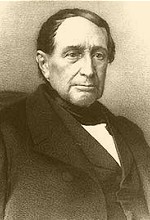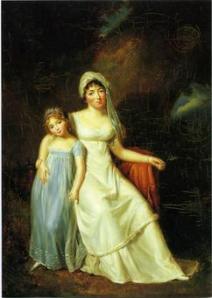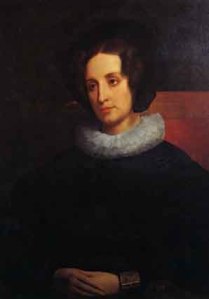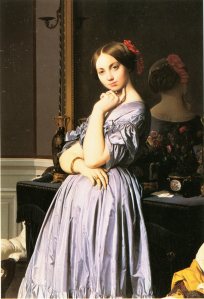 In his will dated June 19, 1839 Duke Victor de Broglie wrote of his links with François Guizot: “I consider our long friendship as one of the most precious gifts that God has given me”, which was the greatest expression of emotion that this very reserved personality was capable of. Their friendship, already of some twenty years standing, was to last another thirty years until Broglie’s death on January 25, 1870. It was then that Guizot discovered these words, revealed to him by Albert, the elder son of the deceased, some two weeks later. And it was also with this sentence that Guizot began his biography of the Duke de Broglie, one of his last books, published in 1872. To his friends and family, he wrote as if in echo: “I have lost my oldest, my best and my rarest friend.” At the outset, there was nothing that seemed likely to bring together to this degree of intimacy the Catholic nobleman, descending from a long line of Marshals of France and brought up in Paris, and the Protestant bourgeois without ancestors, educated in Geneva. Their temperaments were almost diametrically opposed, the former an introvert devoid of eloquence, bluff and sometimes haughty, stubborn in his ideas and hating disorder or the unexpected, the latter infinitely sociable, a tireless speaker, passing easily from one activity to the next, and driven by ambition that the other almost entirely lacked. But they were the same age – Broglie was two years older – and history had dealt them a similar hand. Prince Victor de Broglie, a liberal Deputy in the Constituent Assembly, then Chief of Staff in the Rhine army, was guillotined in June 1794 at the age of 37, two months after André Guizot. However, their sons who were orphans during the Reign of Terror never renounced the great principles of the Revolution, especially Broglie, who from 1795 was in close contact with his step-father Voyer d’Argenson, a liberal committed more and more to the left. Under the Empire, they barely rubbed shoulders, even though they were part of the same liberal circles. In 1809, Victor de Broglie became a member of the Council of State and soon left for missions that would take him throughout Europe, from Spain to Poland. The first Restoration led him to the Chamber of Peers. His first public feat was to publicly denounce in the Chamber the accusation against Marshal Ney for high treason, which did not save the latter from execution, but gave his young defender a great reputation for freedom of thought. In February 1816, against the advice of his family who considered it a misalliance, he married the daughter of Germaine de Staël, Albertine, with whom he was very happy.
In his will dated June 19, 1839 Duke Victor de Broglie wrote of his links with François Guizot: “I consider our long friendship as one of the most precious gifts that God has given me”, which was the greatest expression of emotion that this very reserved personality was capable of. Their friendship, already of some twenty years standing, was to last another thirty years until Broglie’s death on January 25, 1870. It was then that Guizot discovered these words, revealed to him by Albert, the elder son of the deceased, some two weeks later. And it was also with this sentence that Guizot began his biography of the Duke de Broglie, one of his last books, published in 1872. To his friends and family, he wrote as if in echo: “I have lost my oldest, my best and my rarest friend.” At the outset, there was nothing that seemed likely to bring together to this degree of intimacy the Catholic nobleman, descending from a long line of Marshals of France and brought up in Paris, and the Protestant bourgeois without ancestors, educated in Geneva. Their temperaments were almost diametrically opposed, the former an introvert devoid of eloquence, bluff and sometimes haughty, stubborn in his ideas and hating disorder or the unexpected, the latter infinitely sociable, a tireless speaker, passing easily from one activity to the next, and driven by ambition that the other almost entirely lacked. But they were the same age – Broglie was two years older – and history had dealt them a similar hand. Prince Victor de Broglie, a liberal Deputy in the Constituent Assembly, then Chief of Staff in the Rhine army, was guillotined in June 1794 at the age of 37, two months after André Guizot. However, their sons who were orphans during the Reign of Terror never renounced the great principles of the Revolution, especially Broglie, who from 1795 was in close contact with his step-father Voyer d’Argenson, a liberal committed more and more to the left. Under the Empire, they barely rubbed shoulders, even though they were part of the same liberal circles. In 1809, Victor de Broglie became a member of the Council of State and soon left for missions that would take him throughout Europe, from Spain to Poland. The first Restoration led him to the Chamber of Peers. His first public feat was to publicly denounce in the Chamber the accusation against Marshal Ney for high treason, which did not save the latter from execution, but gave his young defender a great reputation for freedom of thought. In February 1816, against the advice of his family who considered it a misalliance, he married the daughter of Germaine de Staël, Albertine, with whom he was very happy. . Becoming a member of this Swiss liberal Protestant family brought him closer to Guizot. Both were named Councillors of State on ordinary service in 1817 and this was the year in which they really met, de Broglie putting his legislative and legal capacities and Guizot his political, administrative and editorial talents to the service of liberal Ministers, from Richelieu to Decazes. In 1818, Broglie joined the “Doctrinaires” group where Royer-Collard and Hercule de Serre were the figureheads, and Guizot the active member. From then on, Guizot wrote, “the more we frequented one another, the more we became from event to event, I could say from day to day, and almost without expressing it, greater and closer friends”. This friendship, which allowed them to be totally frank with one another, originated through politics, which were its driving force until 1848. The main stages were as follows: opposition to the Ultra governments from 1820 to 1828; membership of the Society of Christian morals which they presided over in turn; rejection of Charles X’s ordinances; firm but unenthusiastic acceptance of the revolution of July 1830, which brought them both into the government, Broglie in Public Instruction and Guizot in the Interior; active support of the conservative policy; pillars of the Thiers government of October 11, 1832 from which Broglie, Minister of Foreign Affairs, retired in April 1834 following a hostile and unexpected vote concerning the payment of an indemnity to the United States; President of the Council, still with Guizot, from March 1835 to February 1836. Broglie never accepted a position in a Ministry if Guizot was not a part of it, partly through friendship, but also because he needed the influence his friend wielded over the parliamentary assemblies. This was not the case for Guizot but, although sometimes criticising or offering advice in letters where every word was weighed, Broglie never had a hostile word or gesture towards Guizot, even though he was not a member of the government for the last twelve years of the regime, -“he is as much interested in power as he is in popularity”- wrote Sainte-Beuve. Moreover, when Guizot asked for his help in his relations with England, of which Broglie was also a great admirer and a connoisseur, he agreed to go to London in 1845 to negotiate on the thorny subject of the Right of Search in relation to the slave trade, and then to become ambassador there in 1847. It was there that the February revolution found him.
. Becoming a member of this Swiss liberal Protestant family brought him closer to Guizot. Both were named Councillors of State on ordinary service in 1817 and this was the year in which they really met, de Broglie putting his legislative and legal capacities and Guizot his political, administrative and editorial talents to the service of liberal Ministers, from Richelieu to Decazes. In 1818, Broglie joined the “Doctrinaires” group where Royer-Collard and Hercule de Serre were the figureheads, and Guizot the active member. From then on, Guizot wrote, “the more we frequented one another, the more we became from event to event, I could say from day to day, and almost without expressing it, greater and closer friends”. This friendship, which allowed them to be totally frank with one another, originated through politics, which were its driving force until 1848. The main stages were as follows: opposition to the Ultra governments from 1820 to 1828; membership of the Society of Christian morals which they presided over in turn; rejection of Charles X’s ordinances; firm but unenthusiastic acceptance of the revolution of July 1830, which brought them both into the government, Broglie in Public Instruction and Guizot in the Interior; active support of the conservative policy; pillars of the Thiers government of October 11, 1832 from which Broglie, Minister of Foreign Affairs, retired in April 1834 following a hostile and unexpected vote concerning the payment of an indemnity to the United States; President of the Council, still with Guizot, from March 1835 to February 1836. Broglie never accepted a position in a Ministry if Guizot was not a part of it, partly through friendship, but also because he needed the influence his friend wielded over the parliamentary assemblies. This was not the case for Guizot but, although sometimes criticising or offering advice in letters where every word was weighed, Broglie never had a hostile word or gesture towards Guizot, even though he was not a member of the government for the last twelve years of the regime, -“he is as much interested in power as he is in popularity”- wrote Sainte-Beuve. Moreover, when Guizot asked for his help in his relations with England, of which Broglie was also a great admirer and a connoisseur, he agreed to go to London in 1845 to negotiate on the thorny subject of the Right of Search in relation to the slave trade, and then to become ambassador there in 1847. It was there that the February revolution found him.
When Guizot returned from exile in July 1849, his old friend, then a Deputy, was there to greet him in the port of Le Havre. Broglie did not encourage him back into a governmental post as he was aware of the tensions his name provoked. Broglie himself retired from politics after the Coup d’état of December 2, 1851, supporting for a time but without much conviction the alliance between Legitimists and Orléanists.
 These political vicissitudes did in no way affect the friendship between Guizot and Broglie, which remained firm until the end. It was built on far more solid ground. Very early on, the lives of the two families were intermingled and close ties formed. When Victor and his wife were able to return to the Château de Broglie in the Eure in 1825, all the Guizot family – François, his mother, his wife and his son – were the first to stay there and for decades, their stays in Broglie became a veritable institution. Until he bought Val-Richer in 1836, it was to Broglie that Guizot went to share his joys and sorrows, terminate a book or pursue his electoral campaign. Later on, the proximity of the two estates facilitated mutual visits. There was the eldest daughter Louise, who became Countess Othenin d’Haussonville in 1836
These political vicissitudes did in no way affect the friendship between Guizot and Broglie, which remained firm until the end. It was built on far more solid ground. Very early on, the lives of the two families were intermingled and close ties formed. When Victor and his wife were able to return to the Château de Broglie in the Eure in 1825, all the Guizot family – François, his mother, his wife and his son – were the first to stay there and for decades, their stays in Broglie became a veritable institution. Until he bought Val-Richer in 1836, it was to Broglie that Guizot went to share his joys and sorrows, terminate a book or pursue his electoral campaign. Later on, the proximity of the two estates facilitated mutual visits. There was the eldest daughter Louise, who became Countess Othenin d’Haussonville in 1836  and whose husband was a deputy of the government party from 1842; Albert, born in 1821, a sort of younger brother to François Guizot junior, who would take him twice a week to swimming lessons, and who Guizot launched on a diplomatic career in 1843. On the death of his father, Albert said to him “I ask your permission to do nothing without consulting you first. You are, for me, a second father.” Guizot, who had lost his eldest son in 1837, had kept a close eye on Albert’s adolescence after his mother died in 1838. And finally, there was the younger brother Paul, who for years worked in close collaboration with Guillaume. In the next generation, the links between the Broglie, d’Haussonville, Guizot and de Witt families remained intact. In Broglie, in front of the tomb of the Duke Victor, it was Cornélis de Witt who spoke for the Guizot family. On January 25, 1870 on the last day of his life, Victor had taken his friend’s hand one last time, united one to the other until the very end.
and whose husband was a deputy of the government party from 1842; Albert, born in 1821, a sort of younger brother to François Guizot junior, who would take him twice a week to swimming lessons, and who Guizot launched on a diplomatic career in 1843. On the death of his father, Albert said to him “I ask your permission to do nothing without consulting you first. You are, for me, a second father.” Guizot, who had lost his eldest son in 1837, had kept a close eye on Albert’s adolescence after his mother died in 1838. And finally, there was the younger brother Paul, who for years worked in close collaboration with Guillaume. In the next generation, the links between the Broglie, d’Haussonville, Guizot and de Witt families remained intact. In Broglie, in front of the tomb of the Duke Victor, it was Cornélis de Witt who spoke for the Guizot family. On January 25, 1870 on the last day of his life, Victor had taken his friend’s hand one last time, united one to the other until the very end.